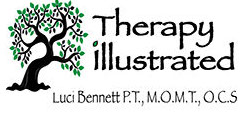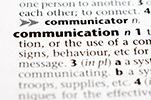


Glossary

Annular Fibrosus- the tough circular exterior of the intervertebral disc that surrounds the soft inner core, the nucleus pulposus. This outer portion is composed of a ring of ligament fibers that encases the inner core of the disc and securely connects the spinal vertebrae above and below.
Biochemical- involving chemical reactions in living organisms.
Biomechanics- the study of external and internal forces on the living body, especially on the skeletal system.
Bone spur- an outgrowth of bone that can occur along the edges of a bone. Bone spurs or osteophytes can form in any bone but are commonly found in joints. They also occur where muscles, ligaments, or tendons attach to the bone.
Collagen- extracellular proteins abundant in the skin, bone, cartilage, tendon, and teeth forming strong insoluble fibers and serving as connective tissue between cells.
Compensation- correction of an organic defect by excessive development or by increased functioning of another organ or unimpaired parts of the same organ.
Cumulative trauma- also known as repetitive strain injury and is defined as a disorder of the muscles, tendons, nerves, and blood vessels caused, perpetuated, or made worse by repeated exertions or movements.
Diagnosis- the art of identifying a disease from its signs and symptoms.
Ergonomics- an applied science concerned with the characteristics of people that need to be considered in designing things that they use in order that people and things will interact most effectively and safely.
Facet joints- the joint structures that connect the vertebrae to one another.
Foramen- a hole or orifice in the bone.
Function- the normal and specific contribution of a bodily part to the economy of a living organism.
Hypermobility- an increase in the range of movement of which a bodily part and especially a joint is capable.
Lamina-the part of the neural arch of a vertebra extending from the pedicle to the median line.
Ligamentum flavum- any of a series of ligaments of yellow elastic tissue connecting the laminae of adjacent vertebrae from the axis to the sacrum.
Microorganism-an organism of microscopic or ultramicroscopic size.
Modalities- a method of therapy that involves physical or electrical therapeutic treatment.
Muscle guarding- a protective response in muscle that results from pain or fear of movement.
Nucleus Pulposus- the soft fibrocartilage central portion of the intervertebral disc.
Nutritionist- a person who uses the science of nutrition to help individuals improve their health.
Osteoarthritis- arthritis typically with onset during middle or old age that is characterized by degenerative and sometimes hypertrophic changes in the bone and cartilage of one or more joints and a progressive wearing down of apposing joint surfaces with consequent distortion of joint position and is marked symptomatically by pain, swelling, and stiffness.
Osteophyte- a pathological bony outgrowth.
Overuse- a sports or occupation related injury that involves repetitive submaximal loading of a particular musculoskeletal unit, resulting in changes due to fatigue of tendons or inflammation of surrounding tissues.
Pathology- the anatomic and physiological deviations from the normal that constitutes disease or characterizes a particular disease.
Proteoglycans- any of a class of glycoproteins of high molecular weight that are found in the extracellular matrix of connective tissue.
Spasm- an involuntary and abnormal contraction of muscle.
Sprain- a sudden or violent twist or wrench of a joint causing the stretching or tearing of ligaments and often rupture of blood vessels with hemorrhage into the tissues.
Stenosis- a narrowing or constriction of the diameter of a passage or orifices.
Strain- when a muscle is stretched too much and tears. It can be caused by an accident, overusing a muscle, or by using the muscle in the wrong way.
The contents of BackPainExplained web site including the text, graphics, images, and other material are for informational purposes only. The content of this web site is not intended to be a substitute for professional medical advice, diagnosis, or treatment. Always seek advice of your physician or other qualified health professional with questions you may have regarding a medical condition. Do not delay seeking medical advice or disregard professional treatment advice because of something that you have read on BackPainExplained.
Call your physician or 911 if you think that you have a medical emergency. Reliance on any information within BackPainExplained web site is solely at your own risk.